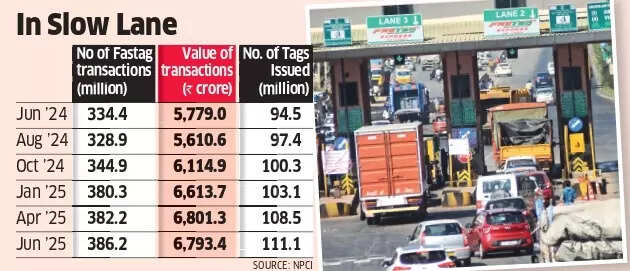Our Terms & Conditions | Our Privacy Policy
Fewer use cases take toll on Fastag growth
Fastag, the modern electronic payment system for vehicle owners and the entire travel ecosystem, is stagnating, with almost negligible growth in the last financial year. Even the number of transactions and banks going live on the payment method remained sluggish during the year.
Lack of evolution of new use cases for Fastag, beyond toll payments, is one of the key factors hindering its growth, said people in the know.
“Toll payments are undertaken by consumers only that many times in a month or a year, and even for commercial vehicles, almost the entire base has been already covered, and the sector is also not growing exponentially,” said a top executive at a digital payments firm which processes Fastag payments. “Overall, the payment method has stagnated at a certain level.”
Data shared by the National Payments Corporation of India, which powers settlements on Fastag, showed 350-380 million transactions are processed on Fastag every month, which has stayed constant since January 2024. In terms of fund settlement, it has hovered between Rs 6,000 and Rs 6,500 crore in the same period. Around 38 banks are currently active on Fastag, unchanged since May 2023.
ETtech
While payment methods are not directly comparable, for context, Unified Payments Interface (UPI), the most popular digital payment method, currently has 675 banks live on the platform. In May 2023, there were 445 banks.
While Fastag was initiated with the aim of digitising highway tolls, its use cases were conceived to be eventually expanded to everything concerning a vehicle such as fuel purchases, and parking payments, among others.
“While a limited number of large commercial properties like shopping malls have started using Fastag as a payment method for their parking fees, fuel has shown almost no adoption,” said the founder of a fintech startup offering this service.
The high cost of installing Fastag-capable gates and tag readers has discouraged smaller commercial estates from adopting them.
“A large mall might be processing around Rs 30 to 40 lakh in parking payments per month, for that, the installation and maintenance might be a bit cumbersome,” the founder added.
He said the average cost of installing a single gate could be around Rs 1.5 to 2 lakh, in addition to maintenance cost.
“There is no margin to be made on fuel payments, hence that use case is also not picking up,” said the executive of a digital payments firm cited above.
Kerbside parking, one of India’s most popular ways of parking vehicles, has also shown no signs of adopting Fastag as a payment method, with transactions mostly through QR codes or cash.
Also Read: Four banks bag bulk of UPI beneficiary payments
Industry insiders also pointed out that the overall disillusionment among fintech startups on generating revenue from digital payments is one of the major reasons behind private firms not taking any fresh initiative on payments. They added that UPI grew in popularity due to large marketing spends into the ecosystem which incentivised customers towards adoption.
“No new-age fintech is pumping funds into digital payments right now. Fastag and such payment methods needed incentives to get more customers to use them readily, in the absence of incentives new use-cases are not building up,” said the founder of a digital payments startup.
Fastag is also plagued by inefficient bank-led customer service, especially during instances of blacklisted tags or recharge issues. While PhonePe, and Amazon Pay are among Fastag distributors, they rely on banks for customer service, where the experience is often subpar.
“Banks make money on the float they get through these payments, otherwise there is hardly any incentive for others to offer superior customer experience,” said the founder cited above.
Images are for reference only.Images and contents gathered automatic from google or 3rd party sources.All rights on the images and contents are with their legal original owners.



Comments are closed.